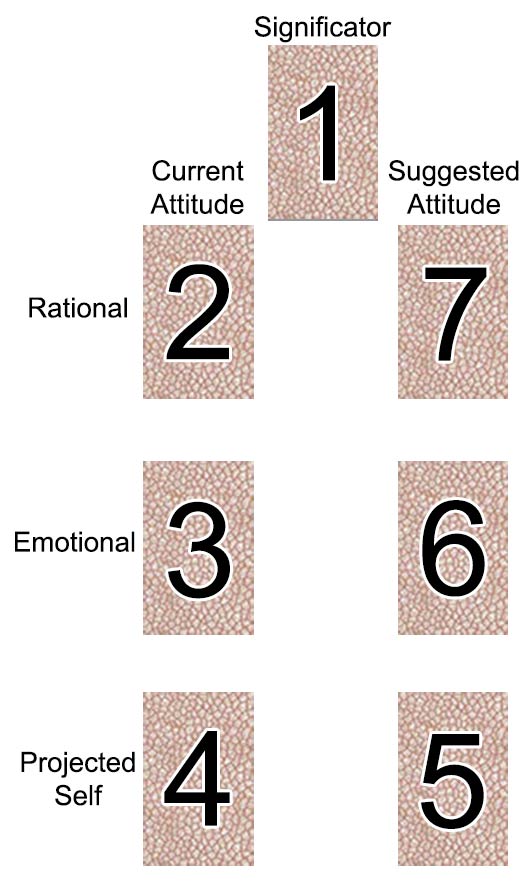Path Spread #1
The Path #1 is laid out in a grid utilizing 2 columns and 3 rows.
The first of the 3 rows shows your rational or intellectual thoughts concerning your question. The second row is concerned with your emotional attitudes, meaning your feelings. The bottom row represents your posture or stance, meaning how you project yourself outwardly, to the world.
The left column shows how you currently think, feel, and act regarding your concern. The right column gives advice on how you would be better served if you changed your attitudes on these 3 levels. The trick is to compare and contrast the 2 columns, which will give you hints as to what the cards mean and how you should make certain changes, small or large.
Spread Positions
- Significator
- Your current attitude
- Your current feelings
- Your current posture
- Suggested posture
- Suggested feelings
- Suggested attitude

Your Path #1 Reading
| Current | The Significator 8 of Swords |
Suggested | |
| Thought |  The Hanged Man |
 9 of Pentacles |
|
| Emotion |  7 of Wands |
 The Star |
|
| Posture |  10 of Pentacles |
 5 of Pentacles |
The Hanged Man
The gallows from which he is suspended forms a Tau cross, while the figure - from the position of the legs - forms a fylfot cross. There is a nimbus about the head of the seeming martyr. It should be noted (1) that the tree of sacrifice is living wood, with leaves thereon; (2) that the face expresses deep entrancement, not suffering; (3) that the figure, as a whole, suggests life in suspension, but life and not death. It is a card of profound significance, but all the significance is veiled. One of his editors suggests that Eliphas Levi did not know the meaning, which is unquestionable nor did the editor himself. It has been called falsely a card of martyrdom, a card of prudence, a card of the Great Work, a card of duty; but we may exhaust all published interpretations and find only vanity. It expresses the relation, in one of its aspects, between the Divine and the Universe.
He who can understand that the story of his higher nature is imbedded in this symbolism will receive intimations concerning a great awakening that is possible, and will know that after the sacred Mystery of Death there is a glorious Mystery of Resurrection.
Divinatory Meaning:
Wisdom, circumspection, discernment, trials, sacrifice, intuition, divination, prophecy.
9 of Pentacles
A woman, with a bird upon her wrist, stands amidst a great abundance of grapevines in the garden of a manorial house. It is a wide domain, suggesting plenty in all things. Possibly it is her own possession and testifies to material well-being.
Reversed Meaning:
Roguery, deception, voided project, bad faith.

7 of Wands
A young man on a craggy eminence brandishing a staff; six other staves are raised towards him from below.
Divinatory Meaning:
It is a card of valour, for, on the surface, six are attacking one, who has, however, the vantage position. On the intellectual plane, it signifies discussion, wordy strife; in business - negotiations, war of trade, barter, competition. It is further a card of success, for the combatant is on the top and his enemies may be unable to reach him.
The Star
A great, radiant star of eight rays, surrounded by seven lesser stars - also of eight rays. The female figure in the foreground is entirely naked. Her left knee is on the land and her right foot upon the water. She pours Water of Life from two great ewers, irrigating sea and land. Behind her is rising ground and on the right a shrub or tree, whereon a bird alights. The figure expresses eternal youth and beauty. The star is l'etoile flamboyante, which appears in Masonic symbolism, but has been confused therein. That which the figure communicates to the living scene is the substance of the heavens and the elements. It has been said truly that the mottoes of this card are Waters of Life freely and Gifts of the Spirit.
The summary of several tawdry explanations says that it is a card of hope. On other planes it has been certified as immortality and interior light. For the majority of prepared minds, the figure will appear as the type of Truth unveiled, glorious in undying beauty, pouring on the waters of the soul some part and measure of her priceless possession. But she is in reality the Great Mother in the Kabalistic Sephira Binah, which is supernal Understanding, who communicates to the Sephiroth that are below in the measure that they can receive her influx.
Reversed Meaning:
Arrogance, haughtiness, impotence.
10 of Pentacles
A man and woman beneath an archway which gives entrance to a house and domain. They are accompanied by a child, who looks curiously at two dogs accosting an ancient personage seated in the foreground. The child's hand is on one of them.
Reversed Meaning:
Chance, fatality, loss, robbery, games of hazard; sometimes gift, dowry, pension.
5 of Pentacles
Two mendicants in a snow-storm pass a lighted casement.
Divinatory Meaning:
The card foretells material trouble above all, whether in the form illustrated - that is, destitution - or otherwise. For some cartomancists, it is a card of love and lovers - wife, husband, friend, mistress; also concordance, affinities. These alternatives cannot be harmonized.

